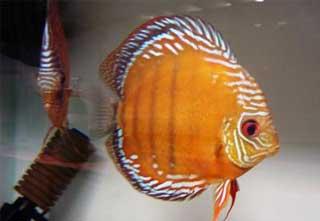Discus - Red
Scientific Name: Symphysodon discus
Wed, 16th April, 2025 - 1:25 am GMT
Sponsor Ads:

Alternative Name
Scientific Name: Symphysodon discusBasic Info
Red Discus are round in shape and are very thin laterally. They can grow to diameters of eight inches (20 centimeters) and are quite graceful in appearance. The Red Discus has a small mouth with such a steeply rising forehead that the fish is nearly perfectly round. Its anal and dorsal fins have long bases and the edges are rounded. Red Discus have saber shaped ventral fins, and caudal fins that are notched. In color, Red Discus are actually not all red. Rather, they have a brownish base color over which green, blue, or red highlights are seen. Although there are nine transverse stripes over the length of their bodies, usually only the fifth and ninth bars are clearly defined. Stripes running horizontally along the body are often evident in turquoise blue or slate blue colors. When breeding, glands in the skin of Red Discus will usually secrete fluids for their young to feed from, in a biological process similar to that of a lactating mammal.
Health
Normally, Red Discus are kept in large aquariums where they have plenty of space and open water in addition to secluded hiding areas. Lighting for Red discus should be dim. Water temperatures for Red Discus should remain between 82 and 86 degrees Fahrenheit (27 to 30 degrees Celsius). A pH of 5.5 to 6.5 is desired, with water hardness levels between 30 and 100 parts per million. Numerous hiding places should be provided, particularly thick, sturdy plants that grow from the bottom of the enclosure to the surface of the water. Red Discus are extremely sensitive to water quality, and their enclosures should undergo weekly water replacement of a fourth to a third in volume. No matter which type of filter you are using, it should have a water turnover rate of two or three times each hour. Usually Red Discus should be kept in groups of five or six fish to reduce stress, and no other species should be kept in the same enclosure. Some people have, however, kept them with smaller fish with good results. Red Discus should be fed a varied diet. A nutritionally complete flake food is often used to make up part of their diets, though you should remember that the most natural diet is often the best diet. The remainder of their food consists of frozen bloodworms and rinsed brine shrimp, in addition to beef heart. Normally, wild food is not preferred because of its tendency to carry parasites that many Red Discus are susceptible to. Red Discus tend to be prone to skin diseases and parasites. If you wish to buy a fish that is very small but brightly colored, you should consider it carefully. It may have been hormone treated. You should also not purchase oval shaped fish, fish with short gill plates or dorsal fins, or oddly shaped eyes if you are wishing to obtain a perfect specimen. Breeding Red Discus are rarely bred in captivity. They have been crossbred with some other Discus species in order to produce new colorations.Habitat
Fresh water fishBehavior
The Red Discus, also known as the Heckel Discus, is a very beautiful and unique display fish or pet. Although these fish have a reputation for being difficult to care for, many enthusiasts state that they are actually not difficult to maintain, as long as careful attention is given to their water quality. Red Discus are considered difficult to keep and breed in captivity. However, most enthusiasts maintain that they are actually not hard to successfully raise. The trick seems to be in keeping the water quality absolutely perfect for these fish. Keeping stress levels to a minimum helps as well. Plenty of hiding places should be provided. Having other fish present may also stress Red Discus, so they should be kept in small groups with other members of their species. It is important not to crowd them. When breeding, Red Discus usually show careful parental care, and protect their fry after hatching, fanning water over them, until they have grown strong enough to swim.Origin
AmazonHistory
The Red Discus is native to the upper regions of the Amazon River, particularly to the Rio Negro region. The water in these regions is warm and slightly acidic and is usually clear and still. The Red Discus is relatively rare in captivity, compared to other Discus species.Common Foods
N/ASponsor Ads:
Thoughts on Programming, Number 14: The expert is a person who avoids the small errors as he sweeps on to the grand fallacy. -Anonymous
Discus - Red
Coded by: BGID® | ALL RIGHTS RESERVED Copyright © 2000-2025
Disclaimer | Privacy | Report Errors / Contact | Credits








 Why haven't we as a collective earth met with aliens yet?
Why haven't we as a collective earth met with aliens yet?  The Best Text Adventure You Will Ever Play! The official site:
The Best Text Adventure You Will Ever Play! The official site:  Homosexual behavior stems from the mind or genetics?
Homosexual behavior stems from the mind or genetics?  World EcoSystem - Biodiversity Changes - Who is on board and who isn
World EcoSystem - Biodiversity Changes - Who is on board and who isn  Mouthwash - Mouthrinse - Mouth Sores - Healing Infections - Gingivitis
Mouthwash - Mouthrinse - Mouth Sores - Healing Infections - Gingivitis  Treatment for Depression
Treatment for Depression  Ultra radical and violent Islamist group that even rivals Al Qaeda
Ultra radical and violent Islamist group that even rivals Al Qaeda  An idea to have teachers who want to carry guns to school undergo some level of police training will be left up to local school districts and police departments.
An idea to have teachers who want to carry guns to school undergo some level of police training will be left up to local school districts and police departments.